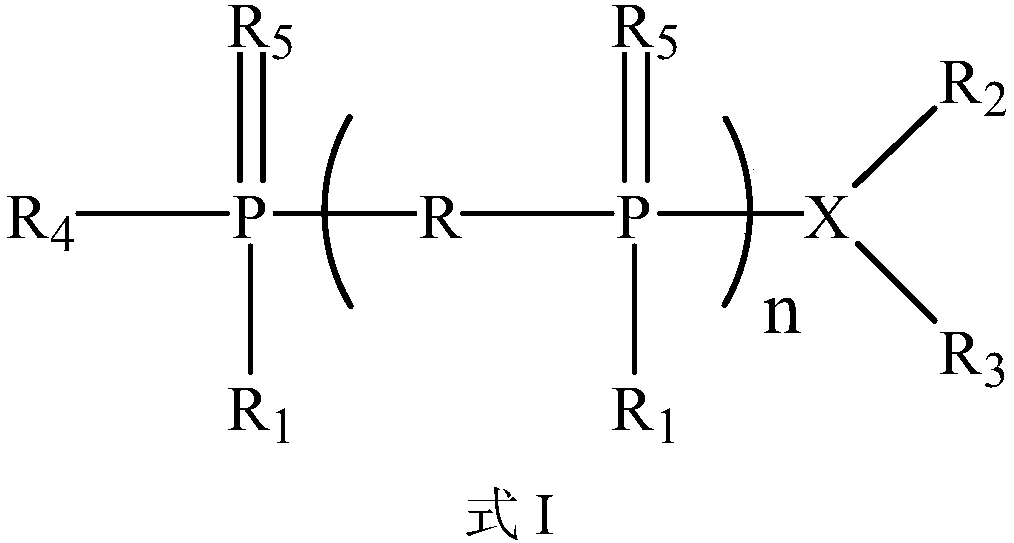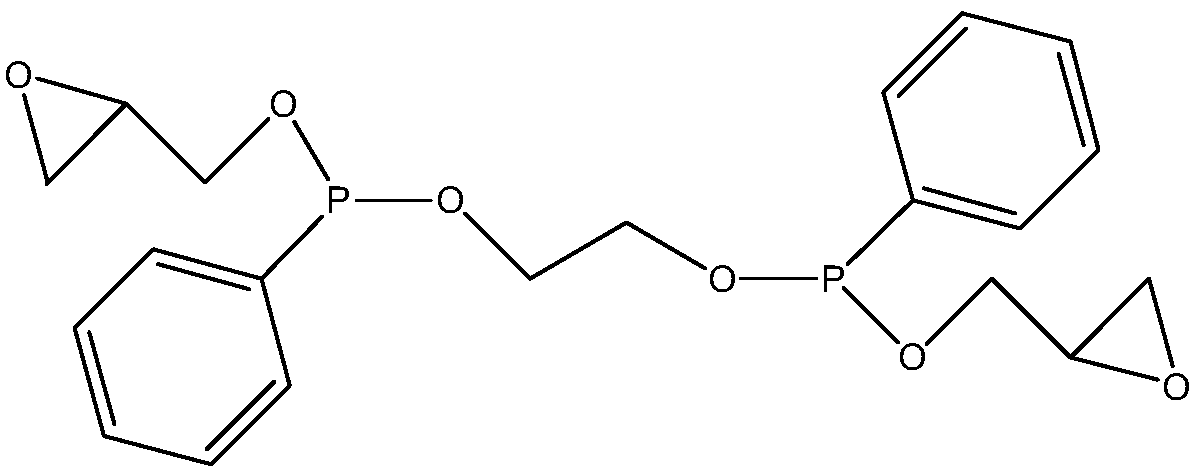Reactive flame retardant, preparation method and application thereof
A flame retardant and reactive technology, applied in the field of reactive flame retardants and their preparation, can solve the problems of reduced mechanical properties, low flame retardant grade, low temperature resistance grade, etc.
- Summary
- Abstract
- Description
- Claims
- Application Information
AI Technical Summary
Problems solved by technology
Method used
Image
Examples
Embodiment 1
[0073] The structure of the reactive flame retardant of the present embodiment is as follows:
[0074]
[0075] The preparation method of this reactive flame retardant is as follows:
[0076] Put 2mol of dichlorophenylphosphine and 200mL of acetone into a three-port 2000ml glass reactor with a stirring device, pass in nitrogen gas, add 1mol of disodium ethylene glycol dropwise for 30 minutes under stirring, continue to react at room temperature for 60 minutes, and then add 2mol of propenyl alcohol dropwise Sodium, continue to react at room temperature for 120min, wash with water to neutrality after the reaction, remove impurities and moisture in the system by physical means, remove the solvent in the system by distillation, add 2.5mol peroxyacetic acid to the obtained solid product, continue to react for 2h, solidify After liquid separation and washing with acetone, 210.62 g of the reactive flame retardant with the above structure was obtained.
[0077] 1 H NMR (CDCl 3 ,...
Embodiment 2
[0079] The structure of the reactive flame retardant of the present embodiment is as follows:
[0080]
[0081] The preparation method of this reactive flame retardant is as follows:
[0082] Put 2 mol of phosphorus trichloride and 200 mL of acetone into a three-port 2000 ml glass reactor with a stirring device, pass in nitrogen, add 1 mol of disodium hydroquinone dropwise for 30 minutes under stirring, continue to react at room temperature for 60 minutes, and then add 4 mol of 2- Sodium butenate, continue to react at room temperature for 120min, after the reaction, remove impurities and water in the system by physical methods, distill off the solvent in the system, add 4.5mol peracetic acid to the obtained solid product, continue to react for 2h, solid-liquid Separated to obtain 201.93 g of the reactive flame retardant with the above structure.
[0083] 1 H NMR (CDCl 3 ,500MHz): δ6.84~6.74(m, 4H, Ar-H), 4.15~4.06(d, 8H, CH 2 ), 3.62~3.51(m, 8H, CH), 1.75~1.68(d, 12H, C...
Embodiment 3
[0085] The structure of the reactive flame retardant of the present embodiment is as follows:
[0086]
[0087] The preparation method of this reactive flame retardant is as follows:
[0088] Put 2 mol of phosphorus oxychloride and 200 mL of acetone into a three-port 2000 ml glass reactor with a stirring device, pass in nitrogen gas, add 1 mol of p-1,4-cyclohexanediol disodium dropwise for 30 minutes under stirring, continue the reaction at room temperature for 60 minutes, and then Add dropwise 4mol sodium acrylate, continue to react at room temperature for 120min, after the reaction, remove impurities and water in the system by physical means, distill off the solvent in the system, add 4.5mol peroxyacetic acid to the obtained solid product, continue to react for 2h, After solid-liquid separation and washing with acetone, 266.37 g of the reactive flame retardant with the above structure was obtained.
[0089] 1 H NMR (CDCl 3 ,500MHz): δ6.05~5.92(d, 8H, CH 2), 4.12~4.06(...
PUM
| Property | Measurement | Unit |
|---|---|---|
| Epoxy equivalent | aaaaa | aaaaa |
| Tg | aaaaa | aaaaa |
| Thermal decomposition temperature | aaaaa | aaaaa |
Abstract
Description
Claims
Application Information
 Login to View More
Login to View More - R&D
- Intellectual Property
- Life Sciences
- Materials
- Tech Scout
- Unparalleled Data Quality
- Higher Quality Content
- 60% Fewer Hallucinations
Browse by: Latest US Patents, China's latest patents, Technical Efficacy Thesaurus, Application Domain, Technology Topic, Popular Technical Reports.
© 2025 PatSnap. All rights reserved.Legal|Privacy policy|Modern Slavery Act Transparency Statement|Sitemap|About US| Contact US: help@patsnap.com



